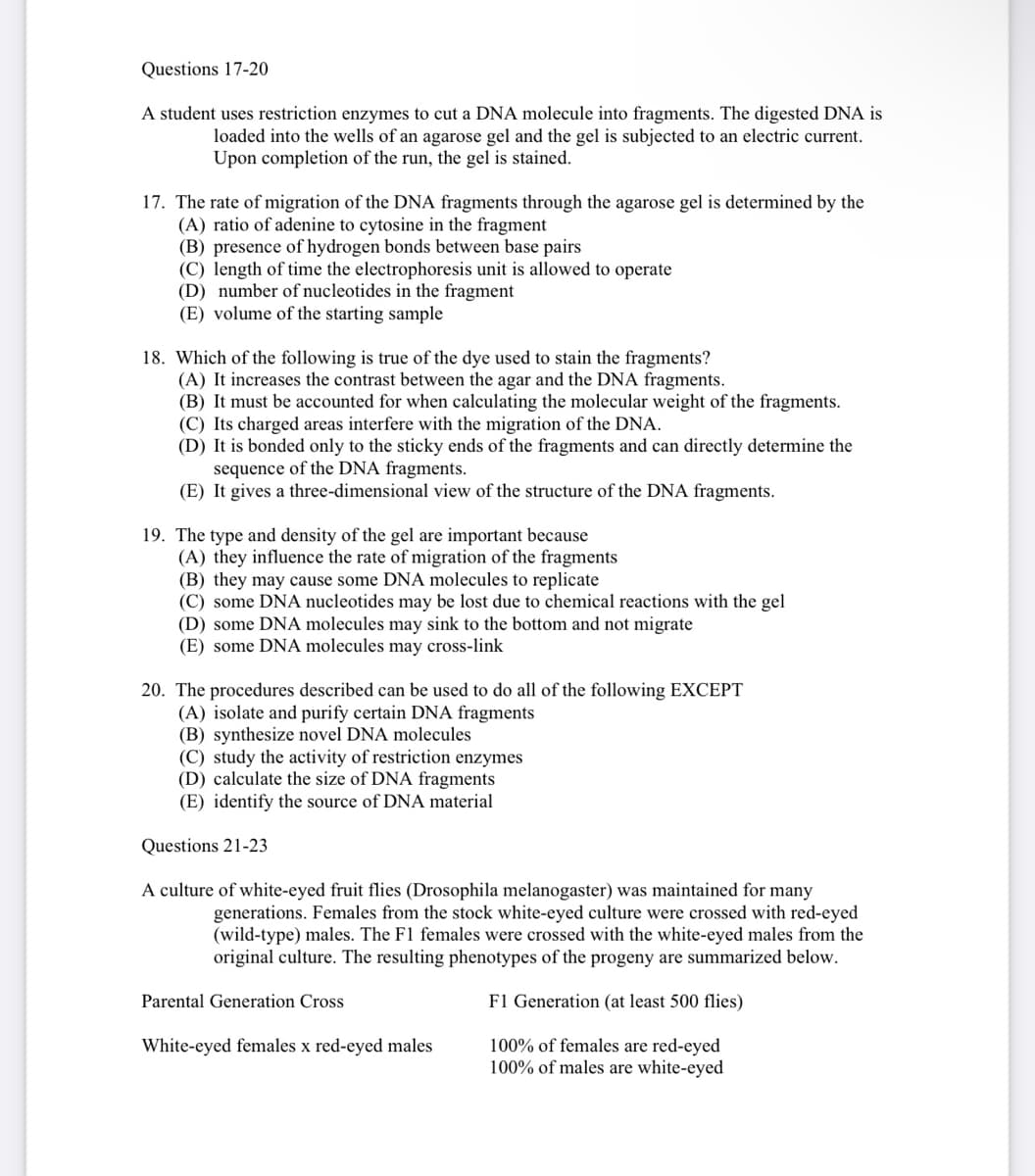Questions 17-20 A student uses restriction enzymes to cut a DNA molecule into fragments. The digested DNA is loaded into the wells of an agarose gel and the gel is subjected to an electric current. Upon completion of the run, the gel is stained. 17. The rate of migration of the DNA fragments through the agarose gel is determined by the (A) ratio of adenine to cytosine in the fragment (B) presence of hydrogen bonds between base pairs (C) length of time the electrophoresis unit is allowed to operate (D) number of nucleotides in the fragment (E) volume of the starting sample 18. Which of the following is true of the dye used to stain the fragments? (A) It increases the contrast between the agar and the DNA fragments. (B) It must be accounted for when calculating the molecular weight of the fragments. (C) Its charged areas interfere with the migration of the DNA. (D) It is bonded only to the sticky ends of the fragments and can directly determine the sequence of the DNA fragments. (E) It gives a three-dimensional view of the structure of the DNA fragments. 19. The type and density of the gel are important because (A) they influence the rate of migration of the fragments (B) they may cause some DNA molecules to replicate (C) some DNA nucleotides may be lost due to chemical reactions with the gel (D) some DNA molecules may sink to the bottom and not migrate (E) some DNA molecules may cross-link 20. The procedures described can be used to do all of the following EXCEPT (A) isolate and purify certain DNA fragments (B) synthesize novel DNA molecules (C) study the activity of restriction enzymes (D) calculate the size of DNA fragments (E) identify the source of DNA material
DNA and RNA
Deoxyribonucleic acid (DNA) is usually called the blueprint of life. Deoxyribose is a monosaccharide that has a key function in the synthesis of deoxyribonucleic acid. One less oxygen-containing hydroxyl group occurs in deoxyribose sugar. Nucleic acid, deoxyribonucleic acid, is one of the natural components. Deoxyribonucleic acid is a double-stranded molecule. Watson and Crick postulated the double-stranded model of the helix. A deoxyribonucleic acid is a molecular group that carries and transmits genetic information from parents to offspring. All eukaryotic and prokaryotic cells are involved.
DNA as the Genetic Material
DNA, or deoxyribonucleic acid, is a long polymeric nucleic acid molecule discovered in the late 1930s. It is a polymer; a long chain-like molecule made up of several monomers connected in a sequence. It possesses certain characteristics that qualify it as a genetic component. Certain organisms have different types of nucleic acids as their genetic material - DNA or RNA.
Genetics
The significant branch in science which involves the study of genes, gene variations, and the organism's heredity is known as genetics. It is also used to study the involvement of a gene or set of genes in the health of an individual and how it prevents several diseases in a human being. Thus, genetics also creates an understanding of various medical conditions.
DNA Replication
The mechanism by which deoxyribonucleic acid (DNA) is capable of producing an exact copy of its own is defined as DNA replication. The DNA molecules utilize a semiconservative method for replication.

Trending now
This is a popular solution!
Step by step
Solved in 2 steps









